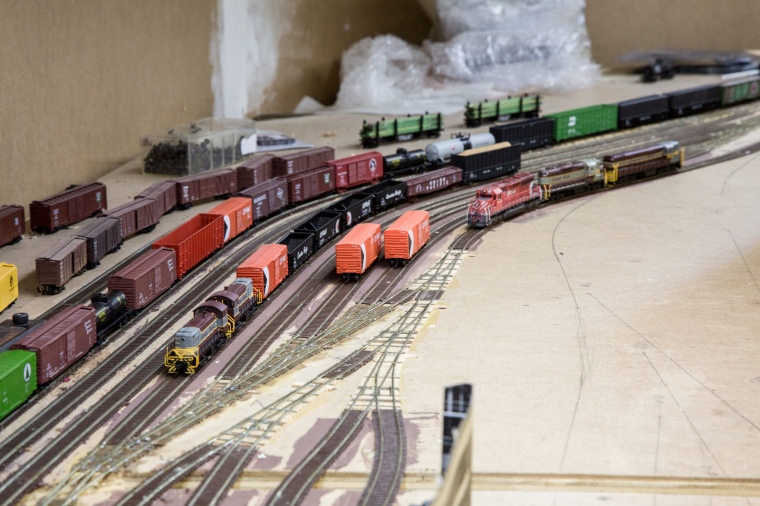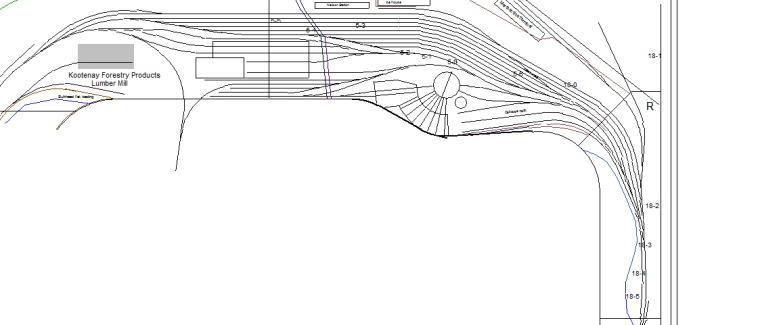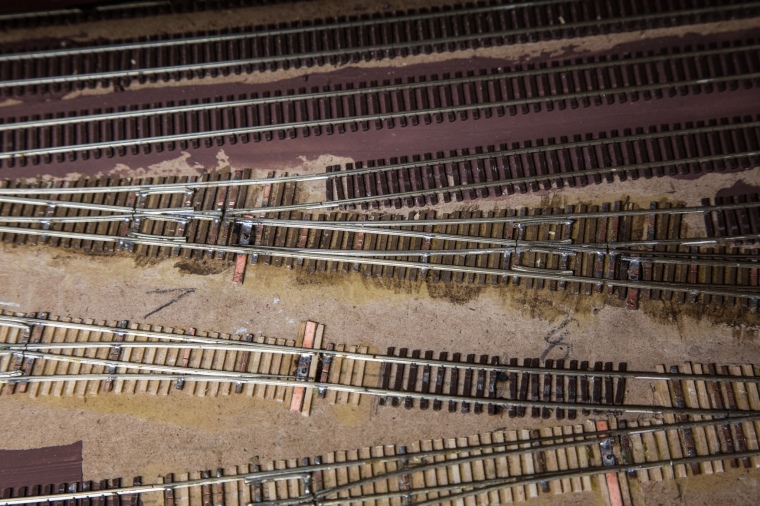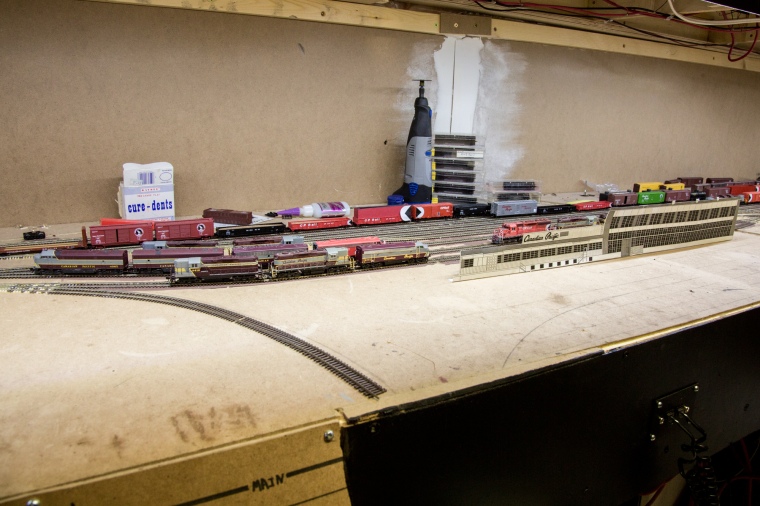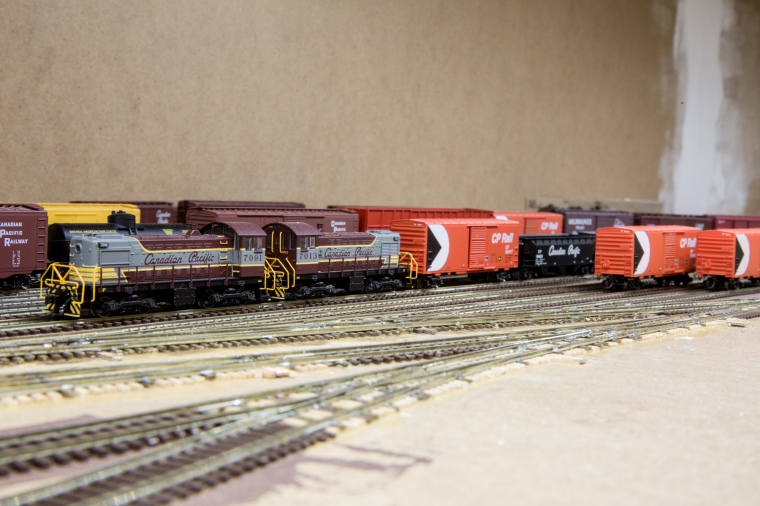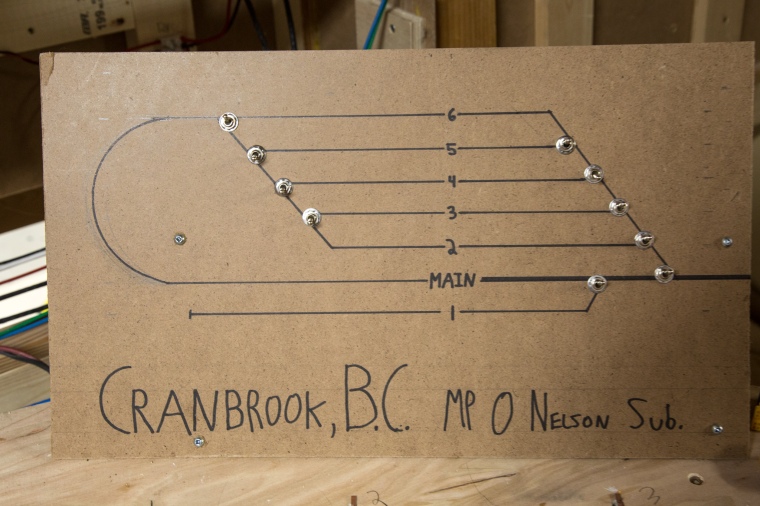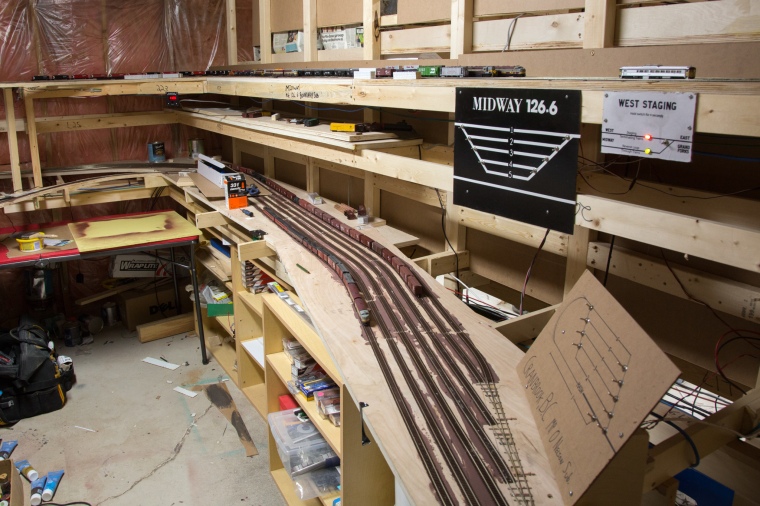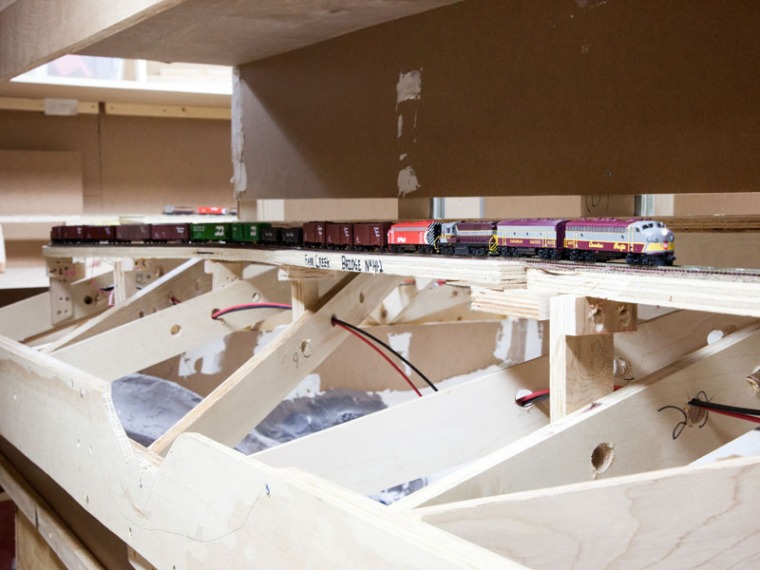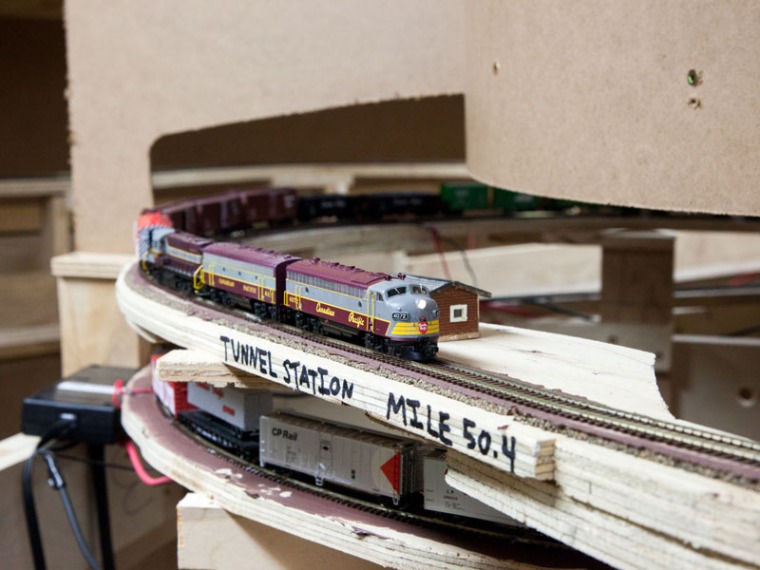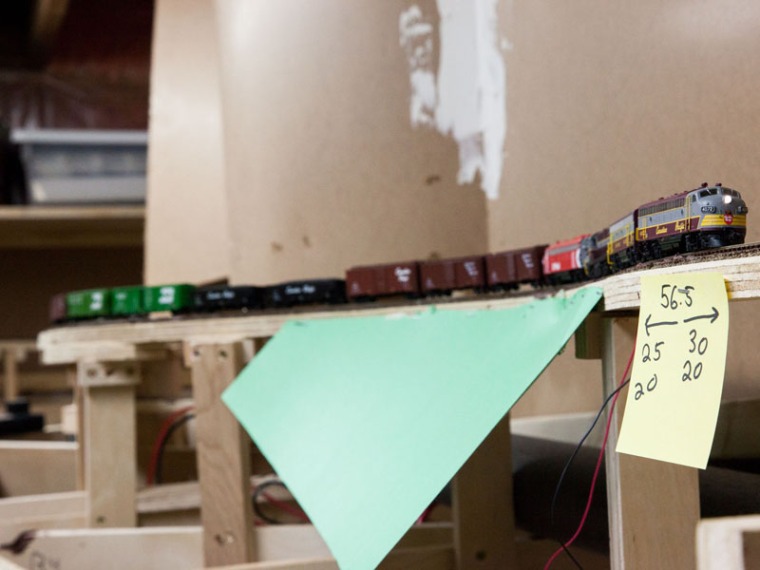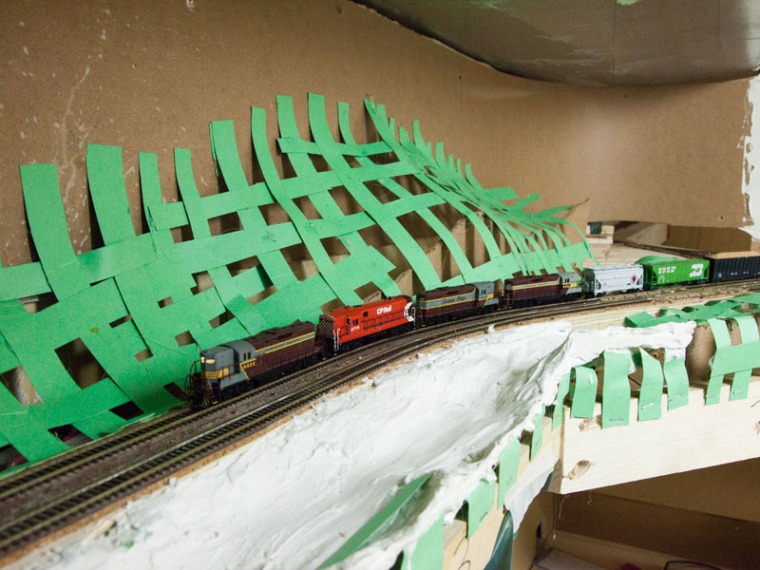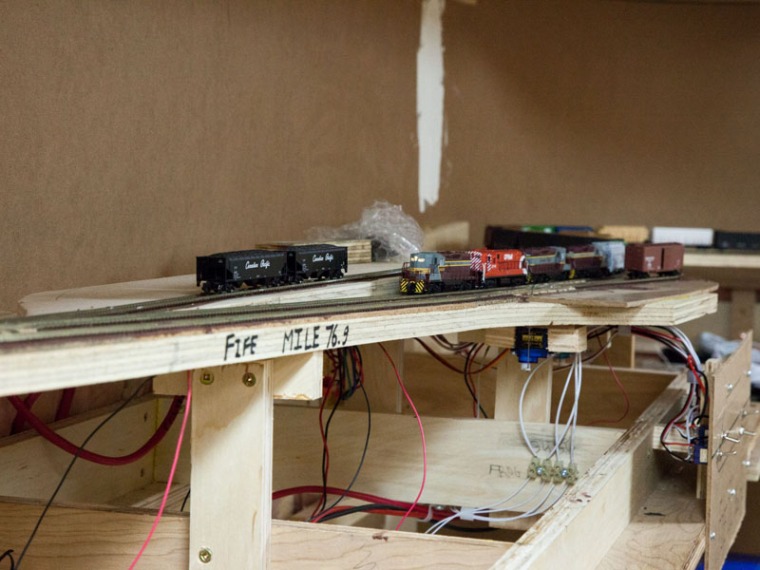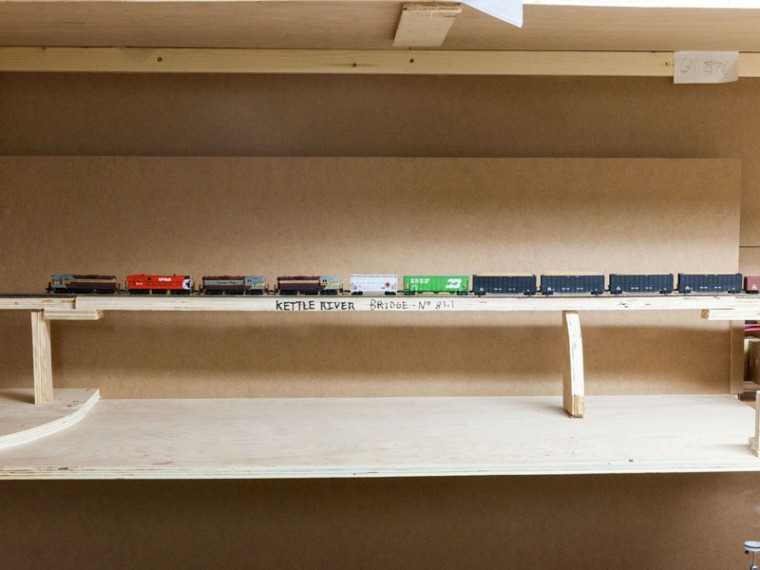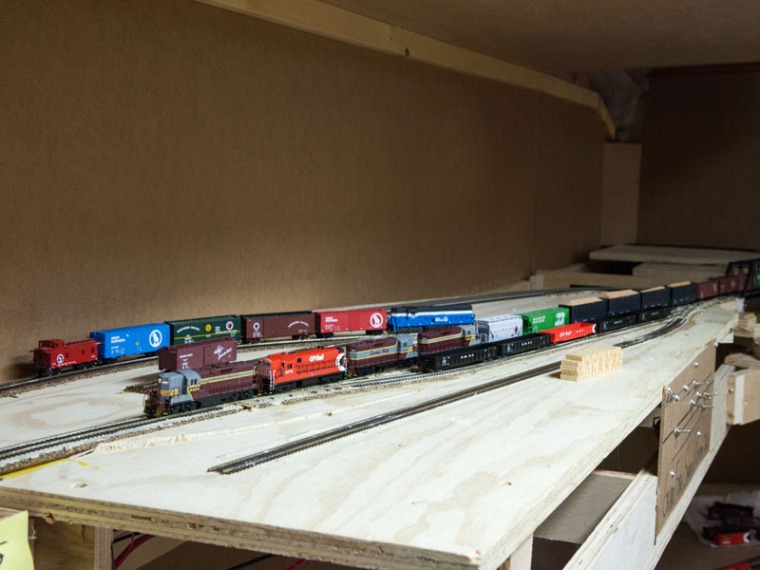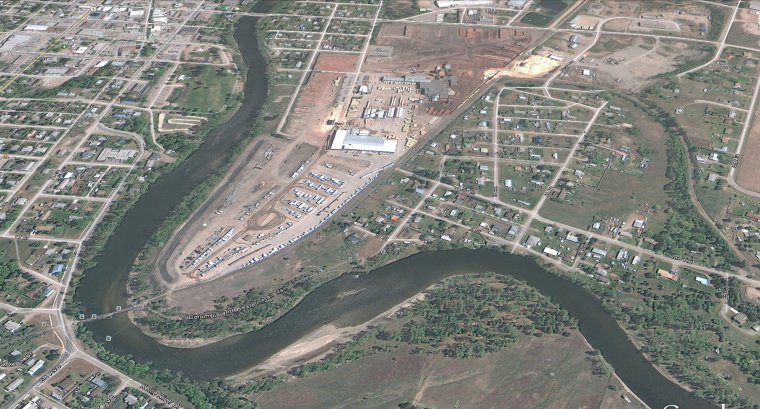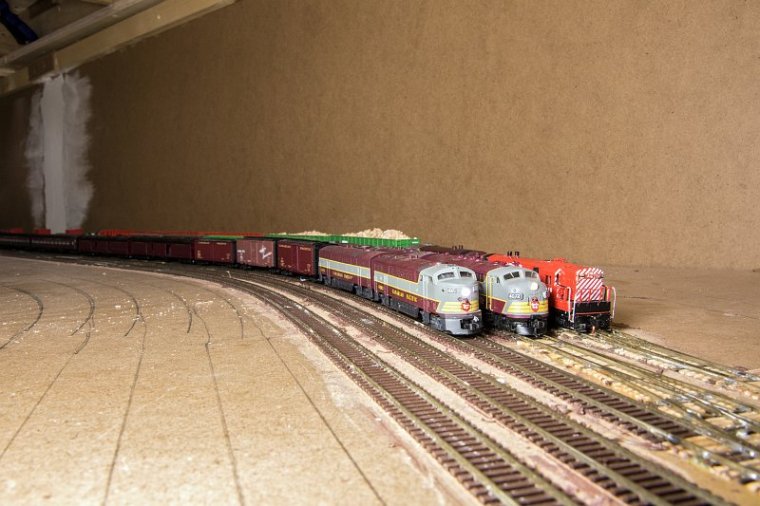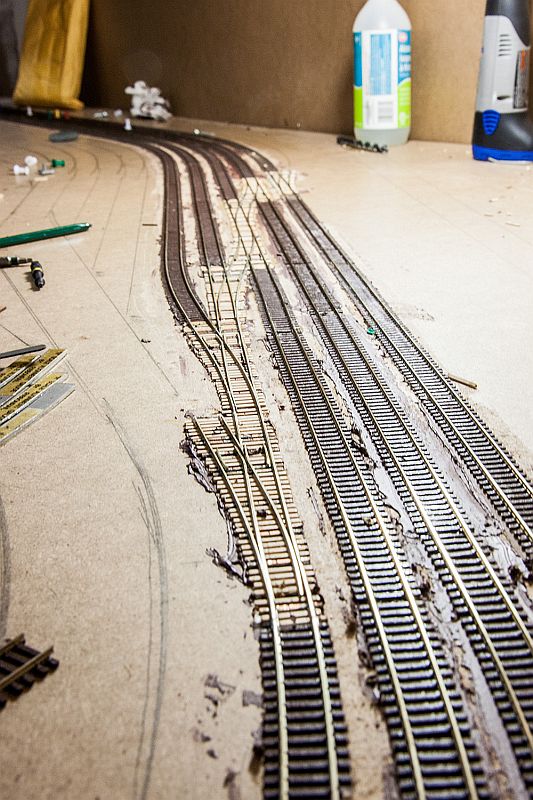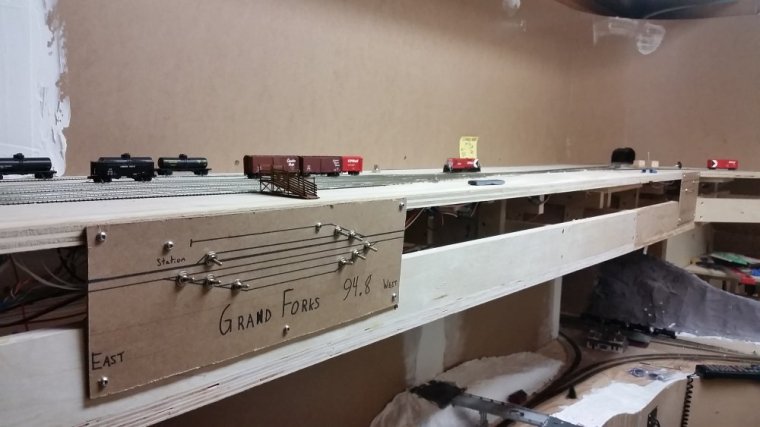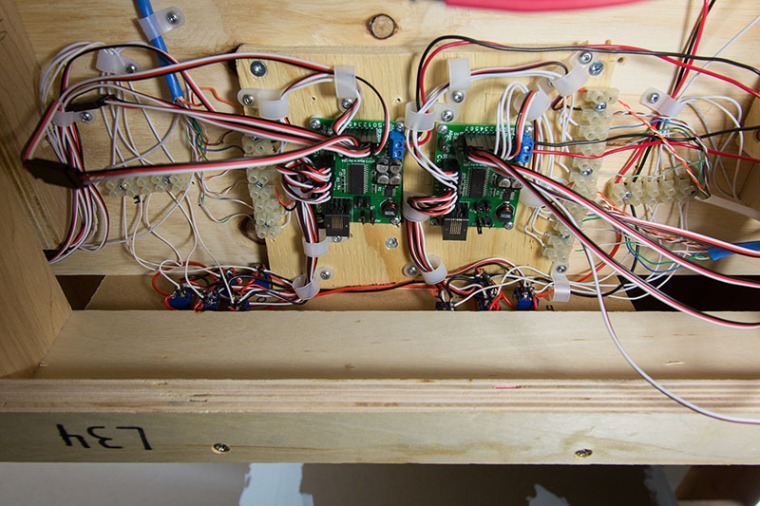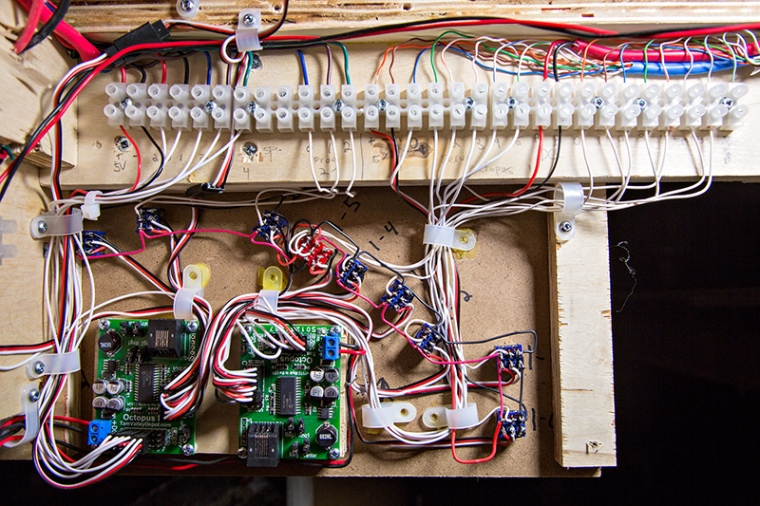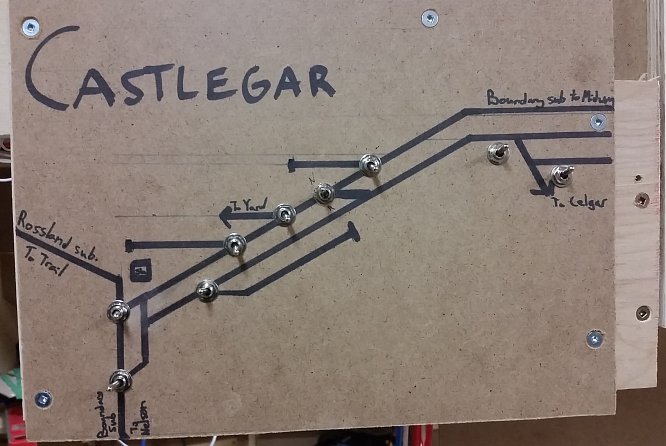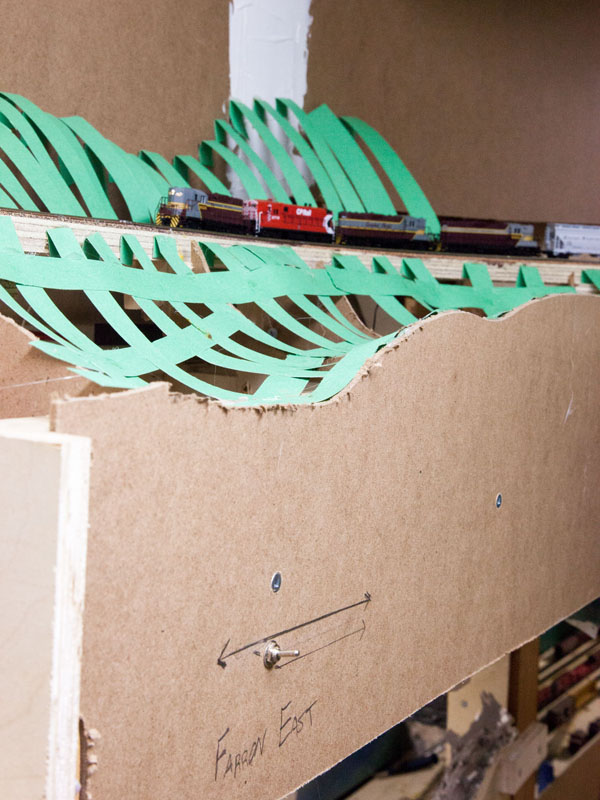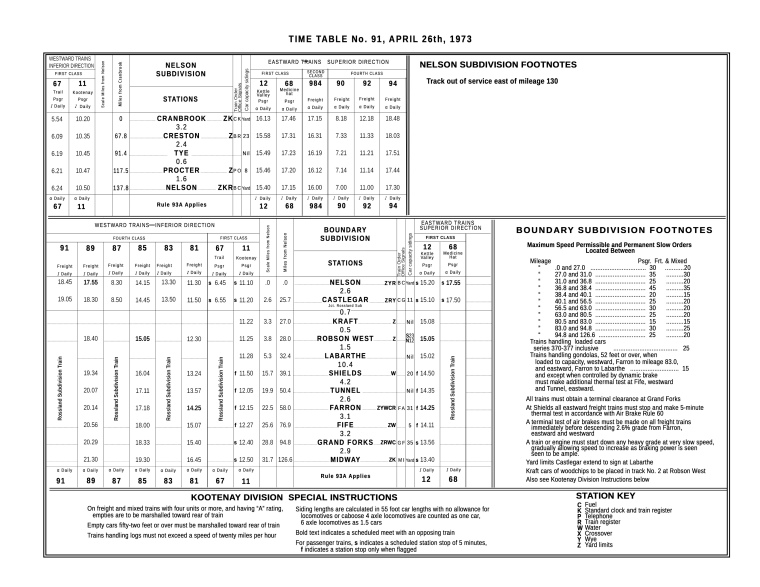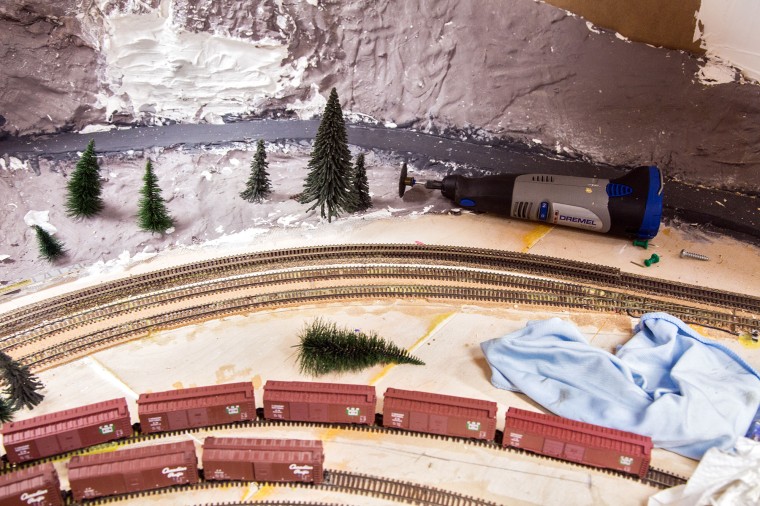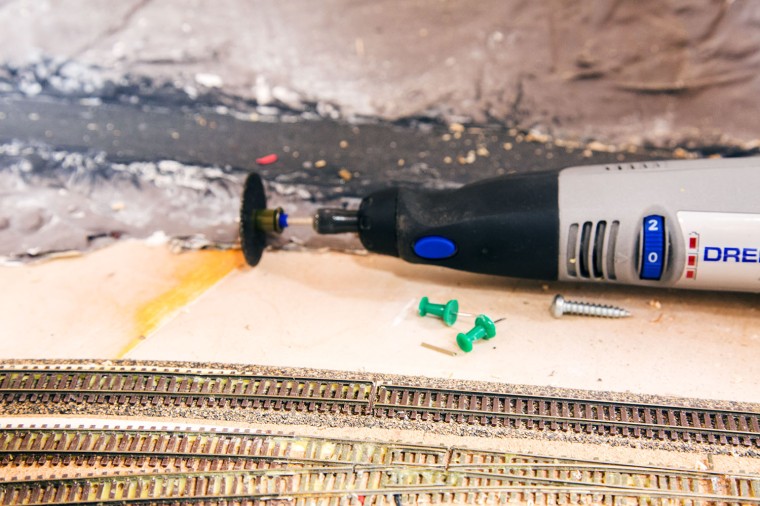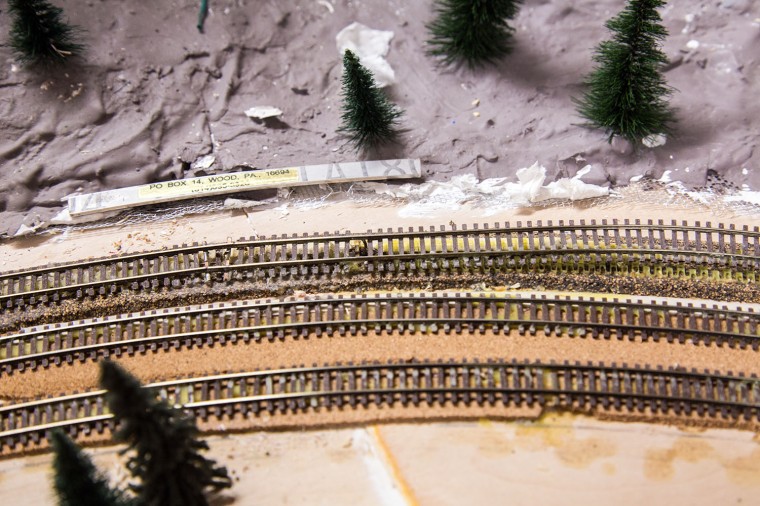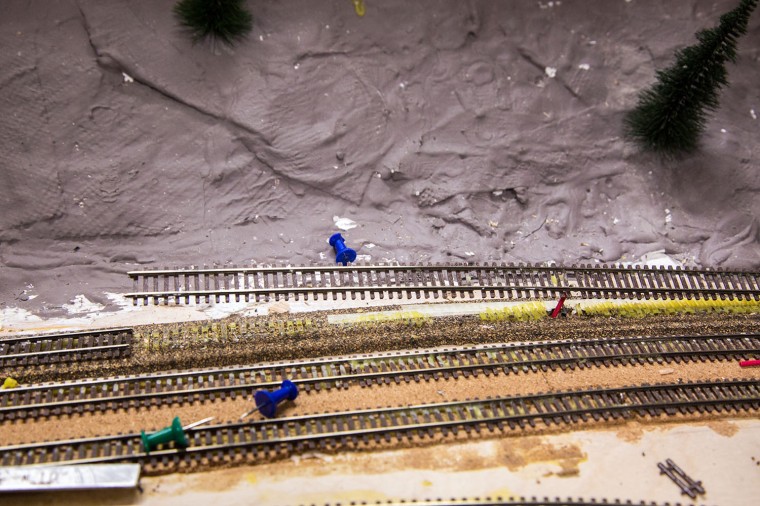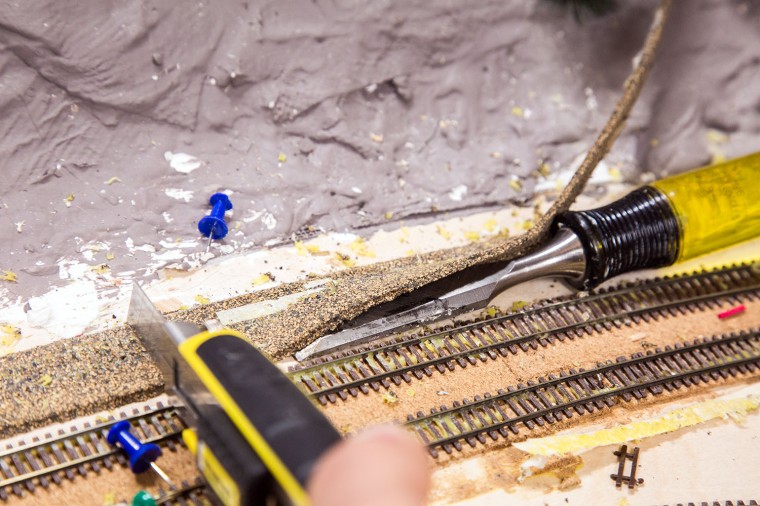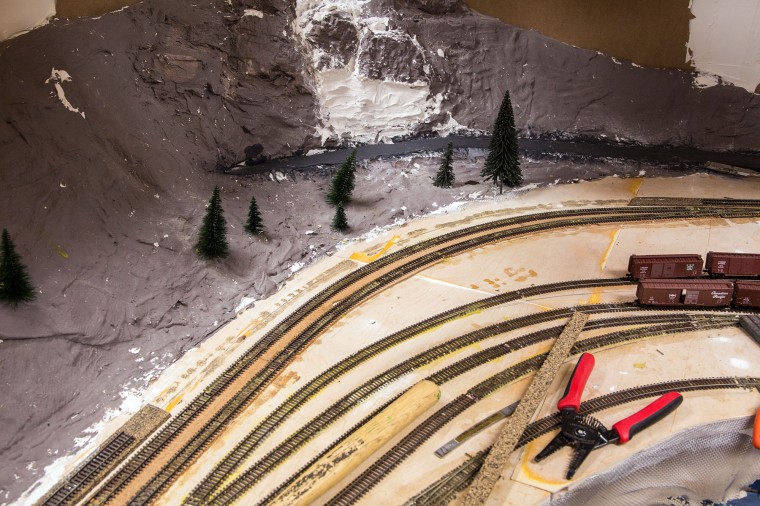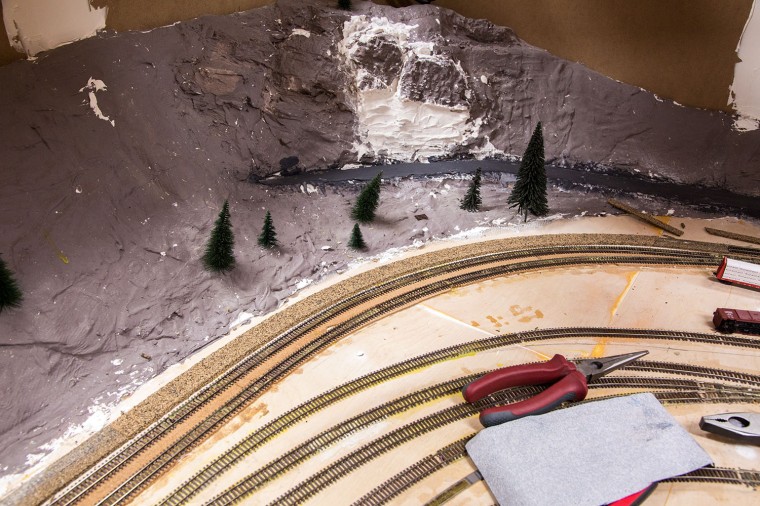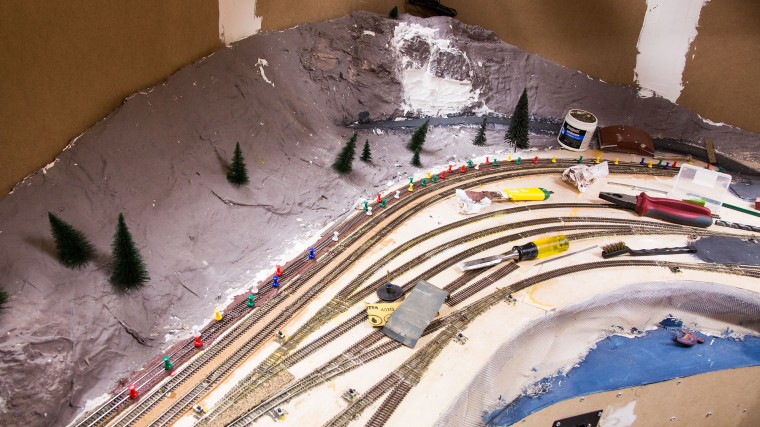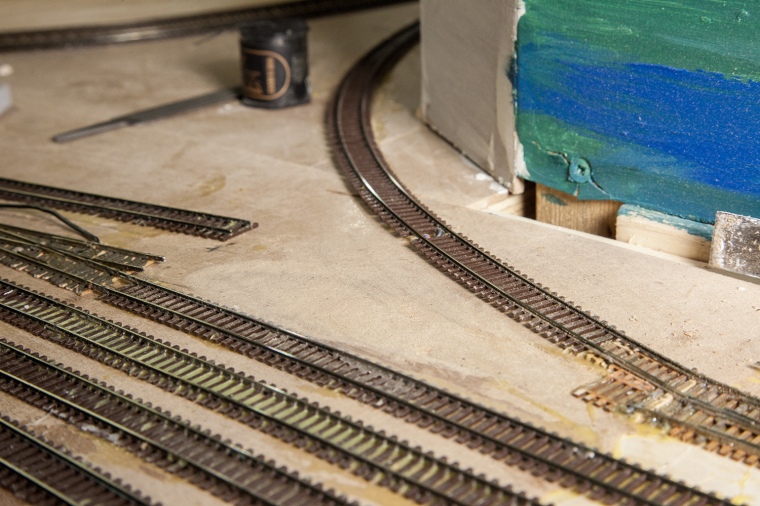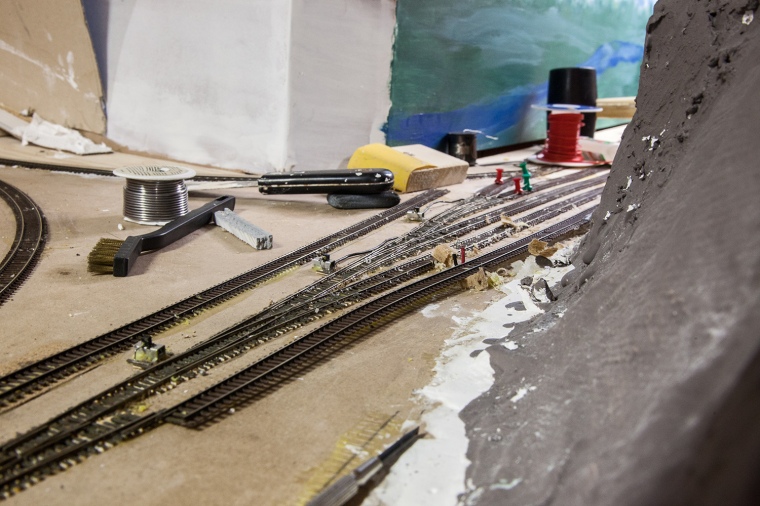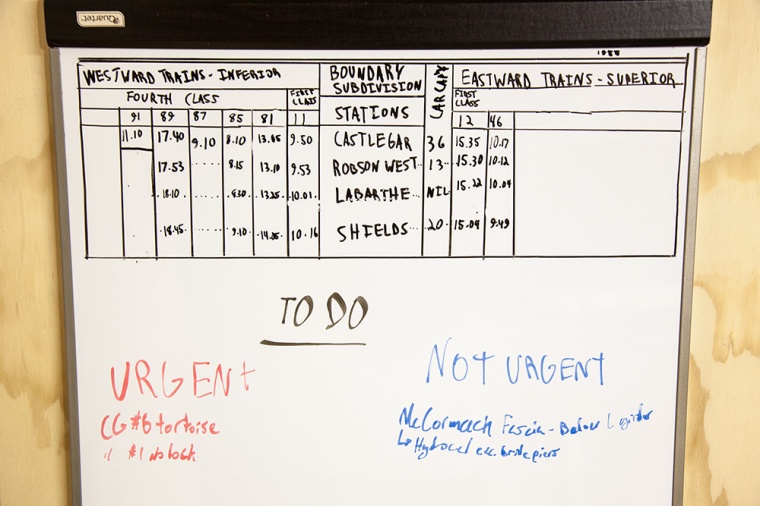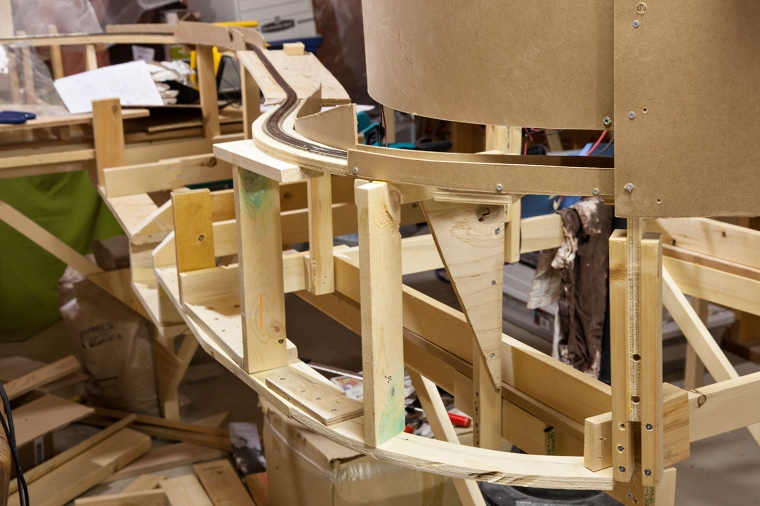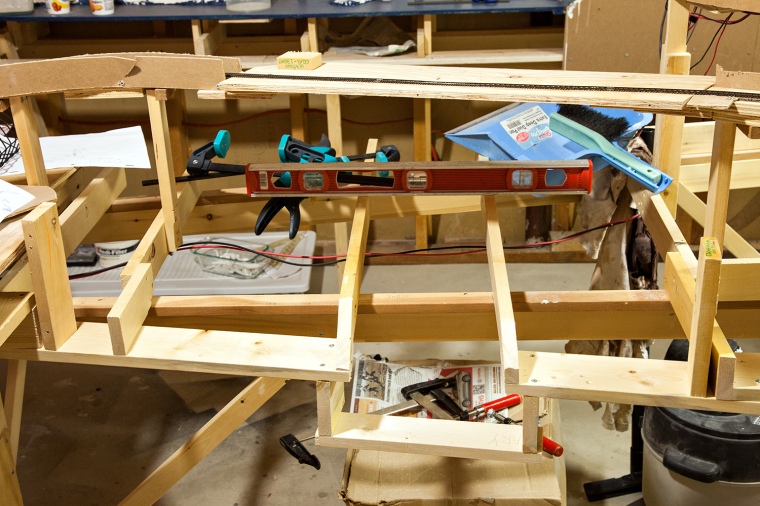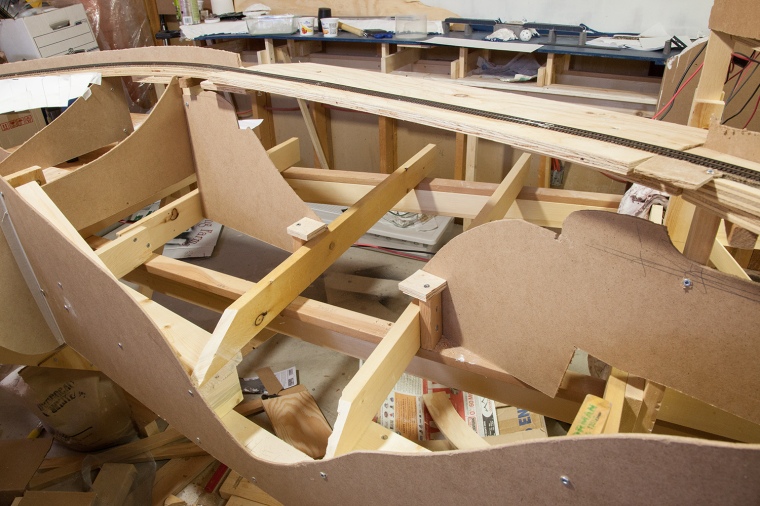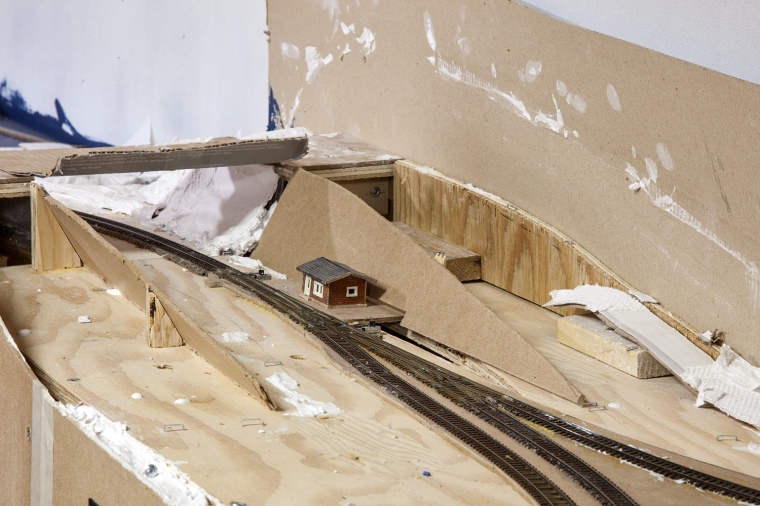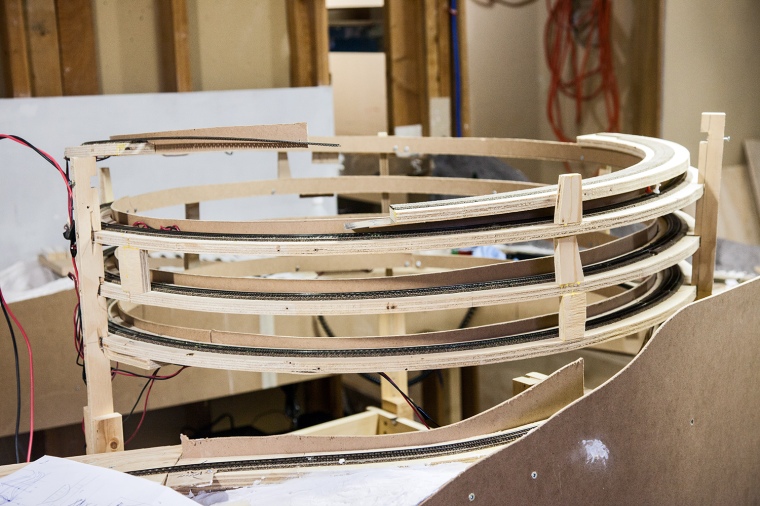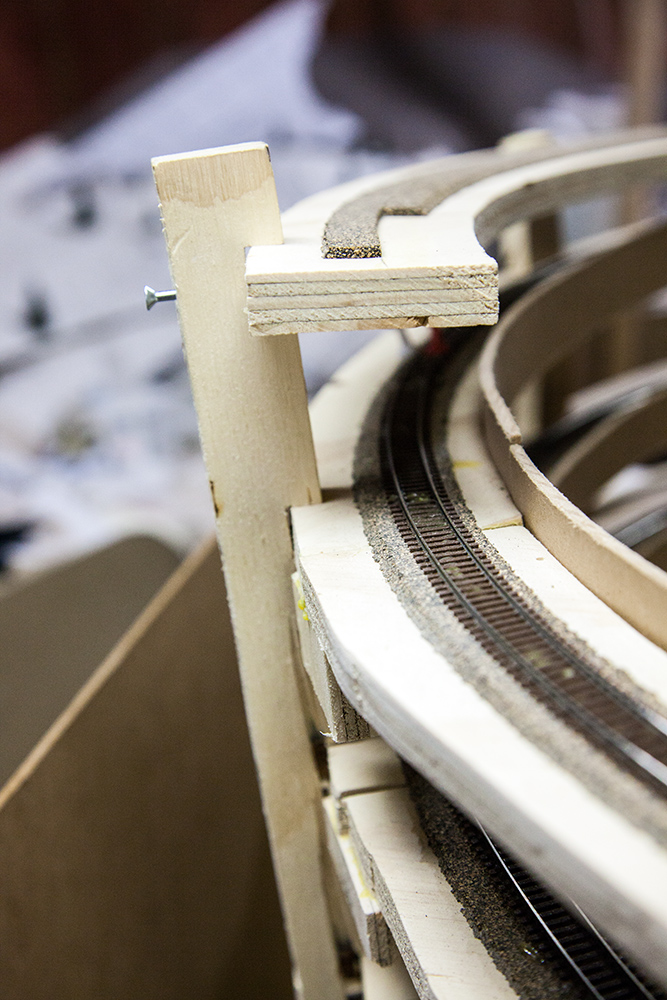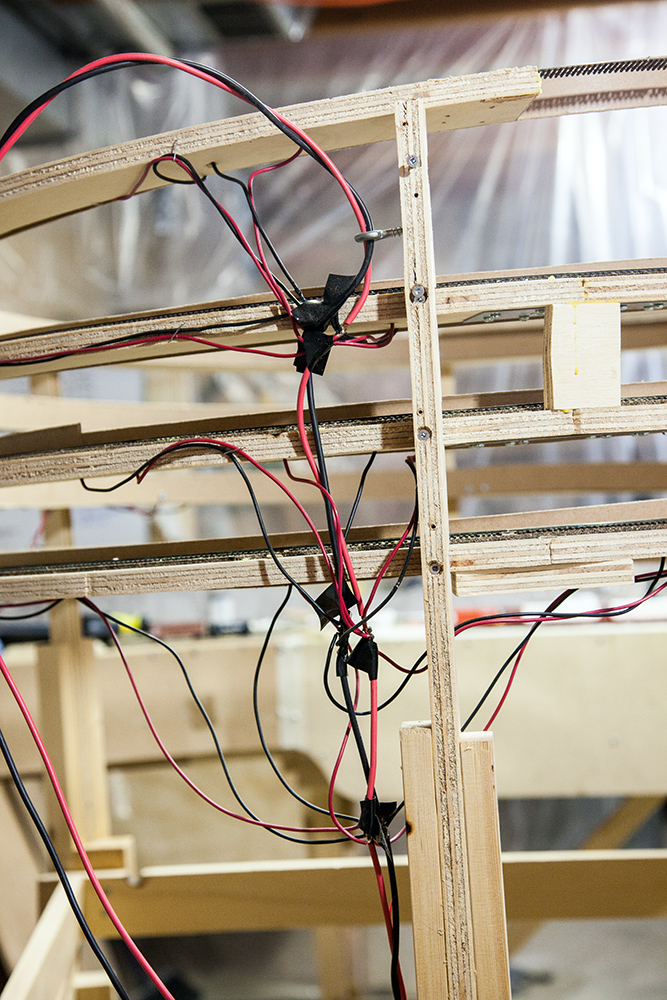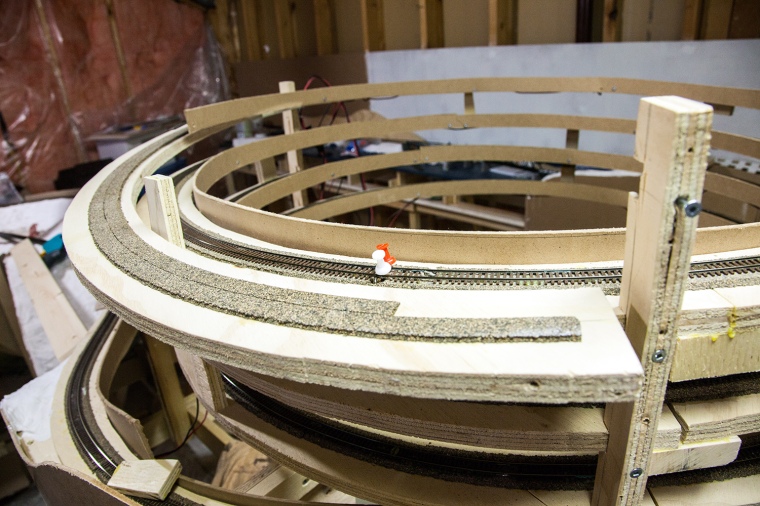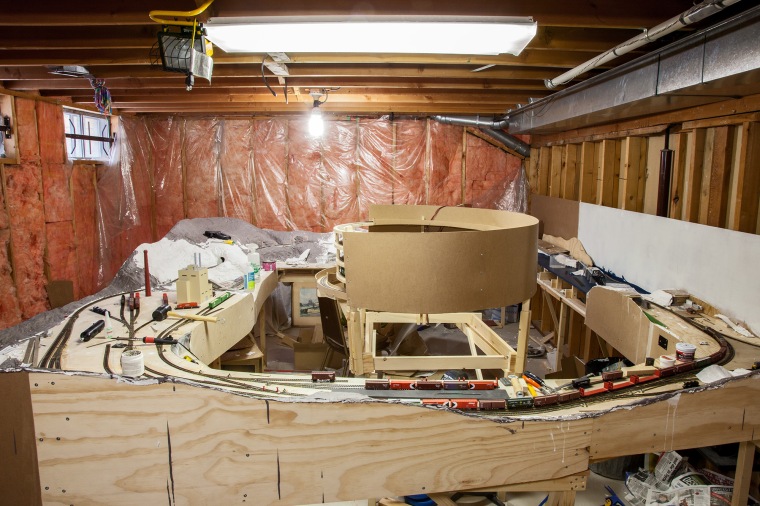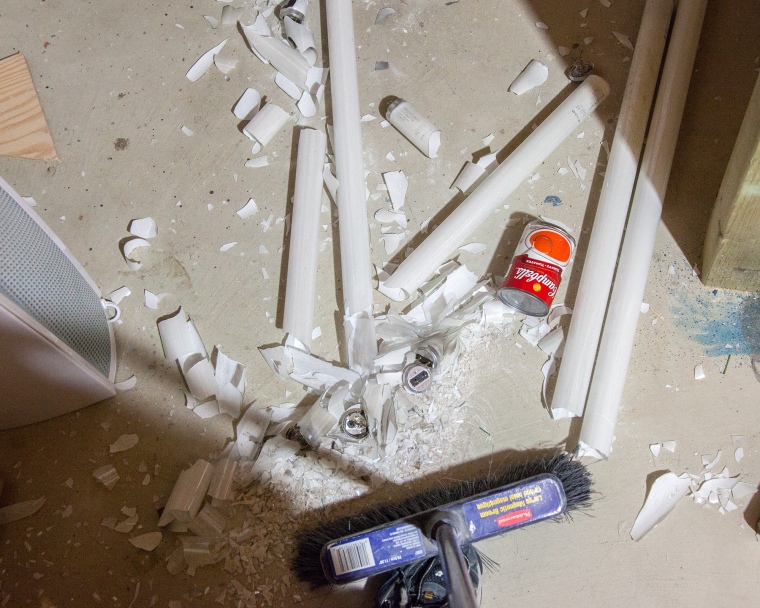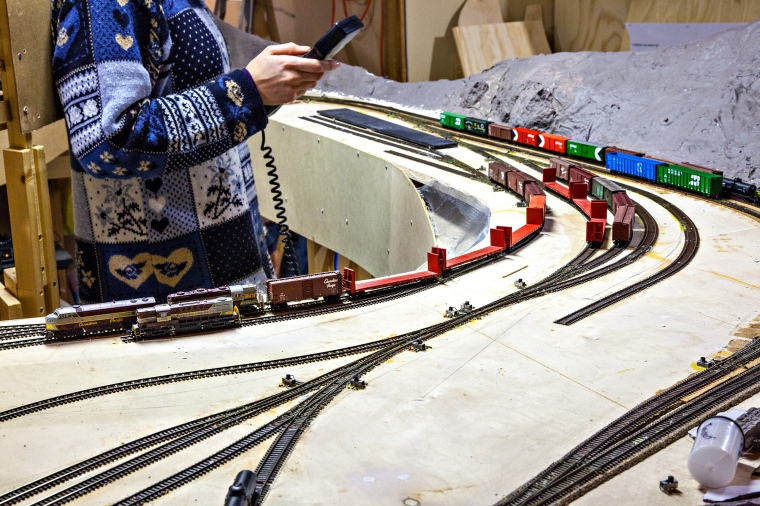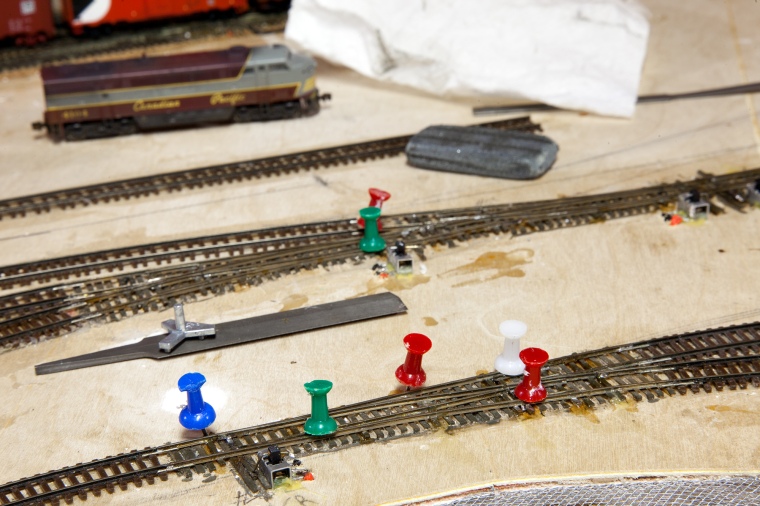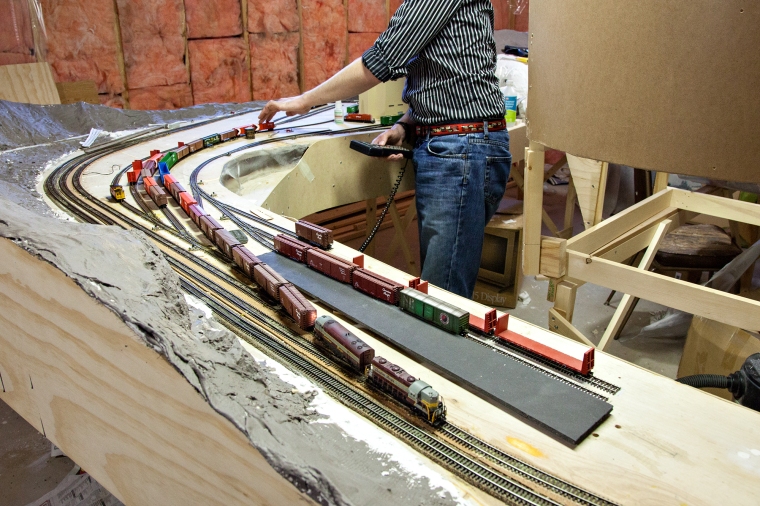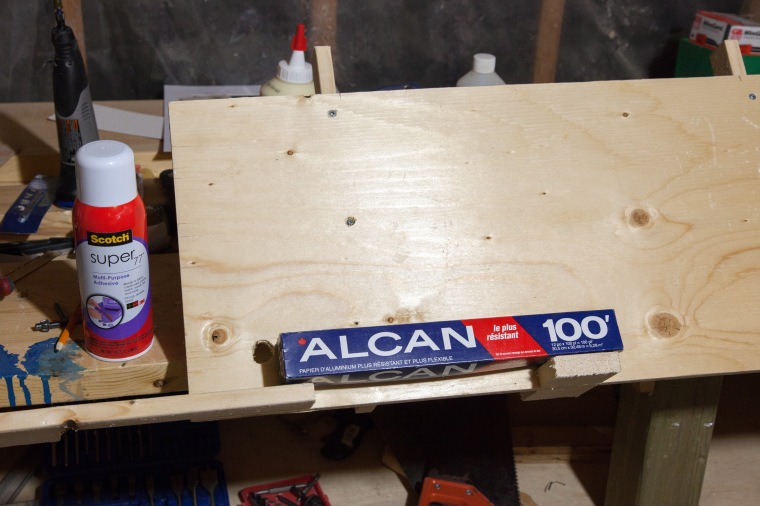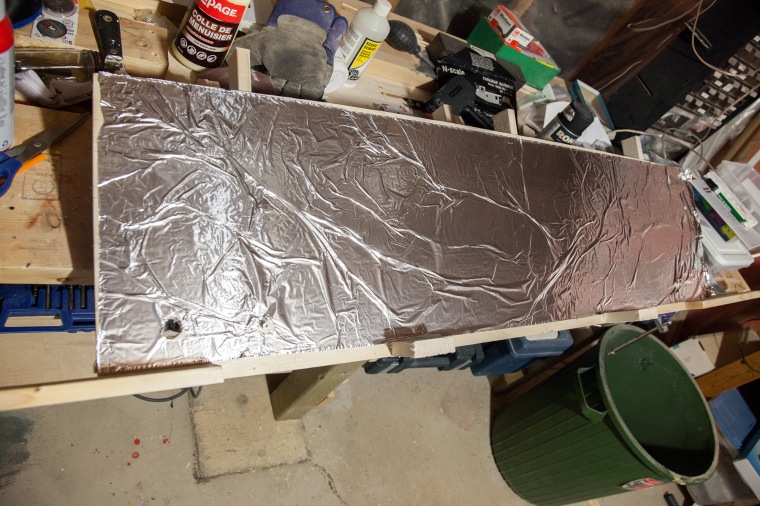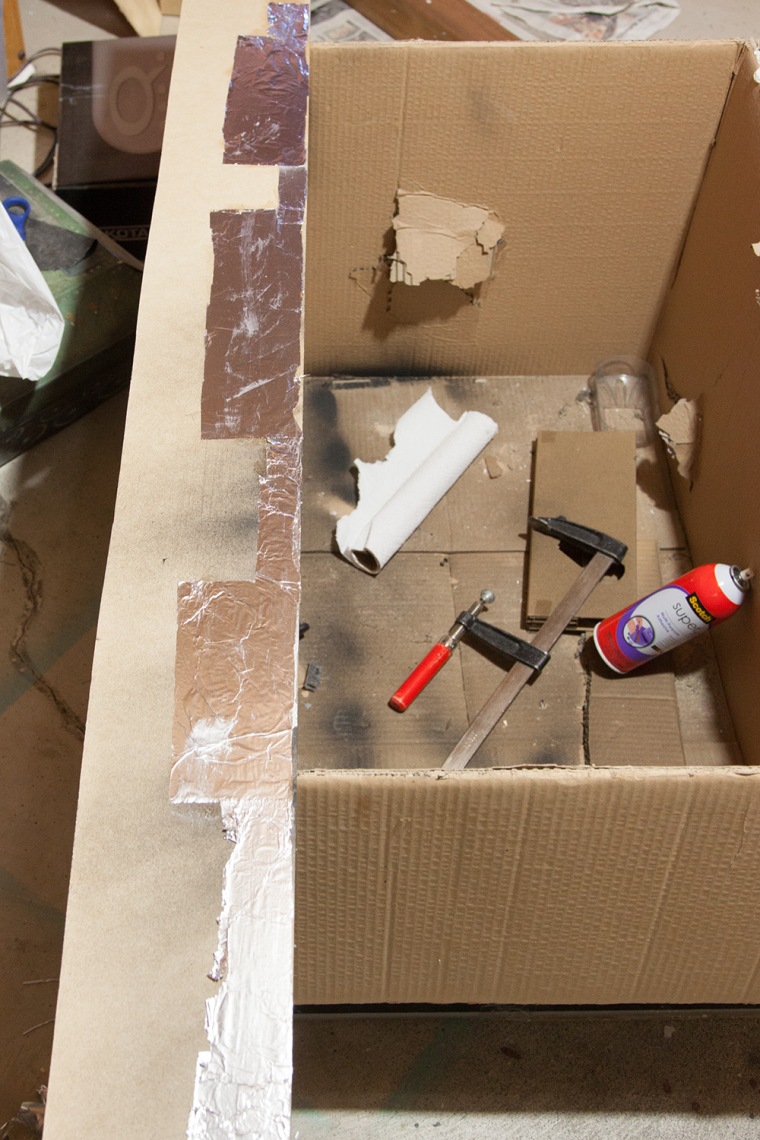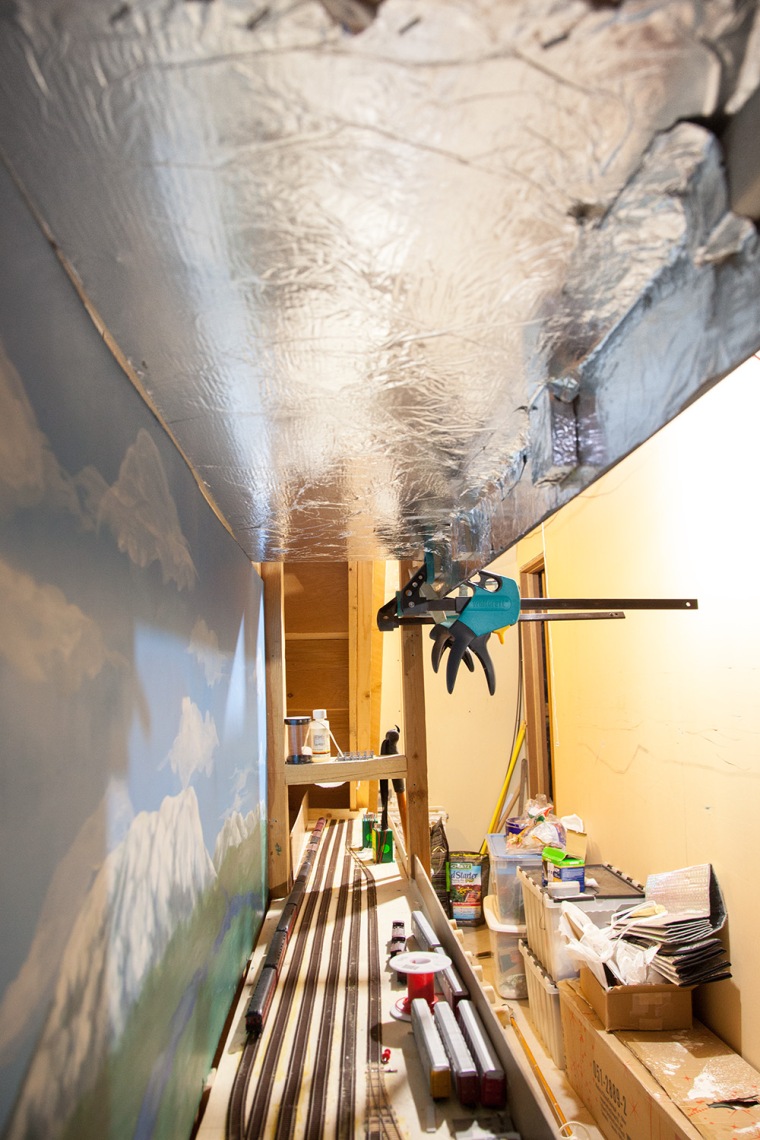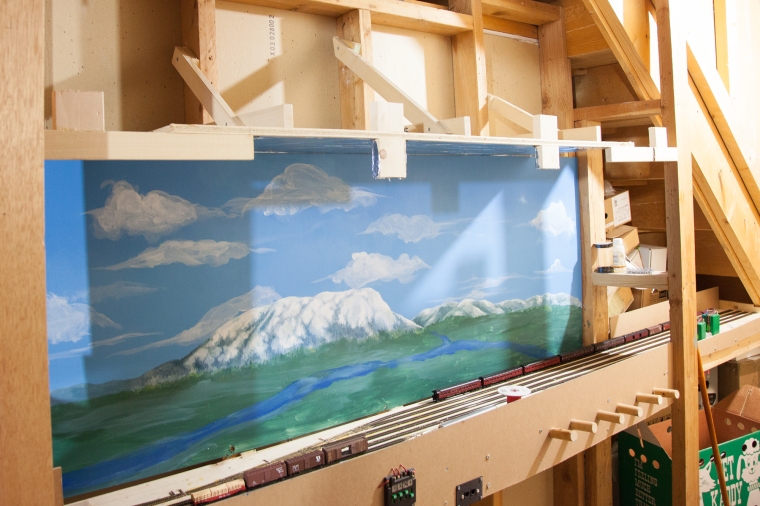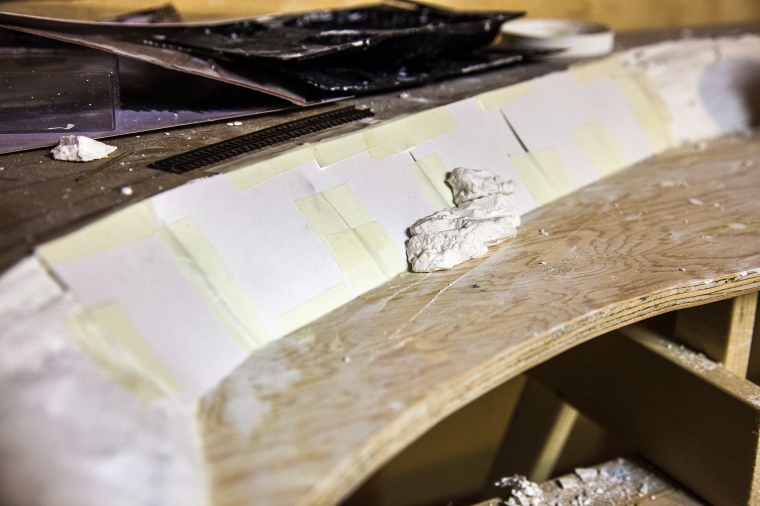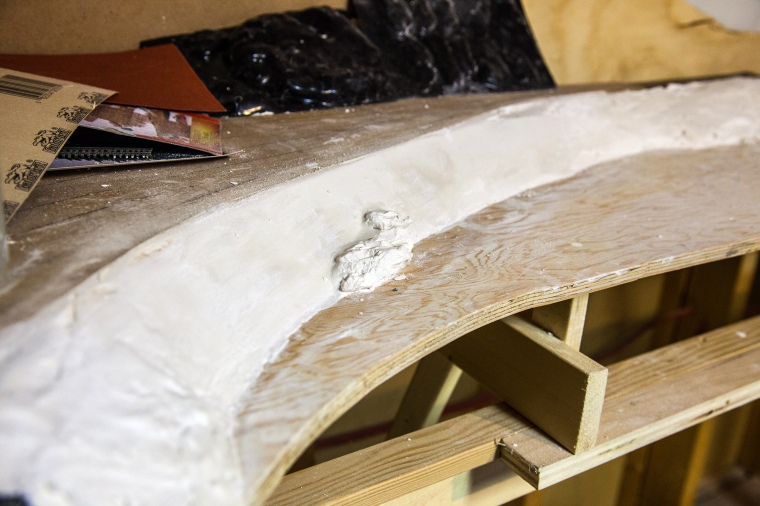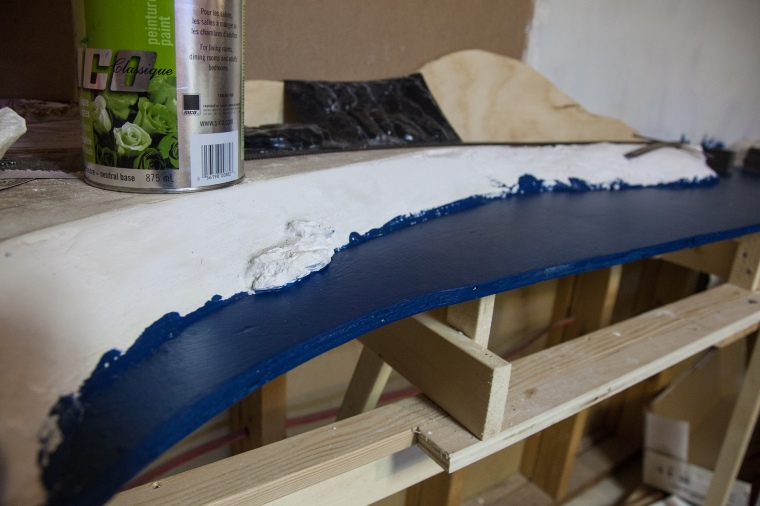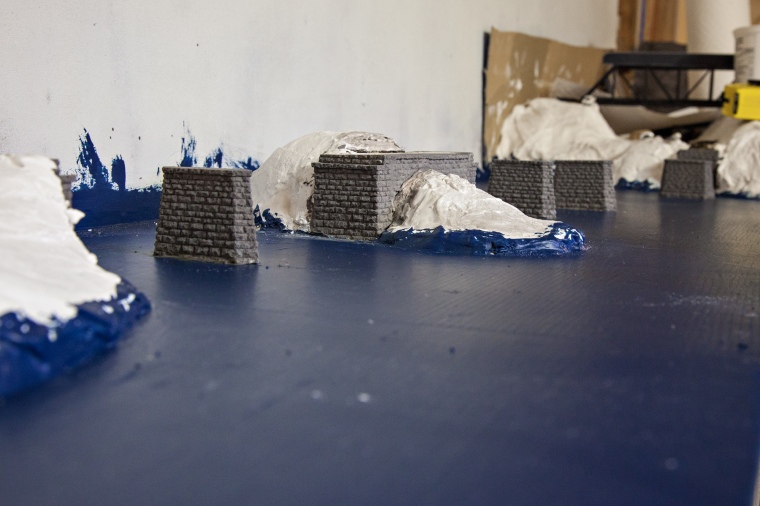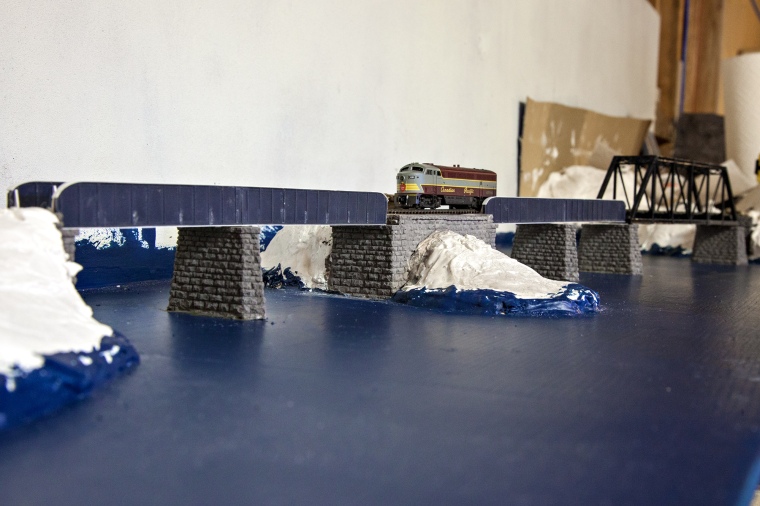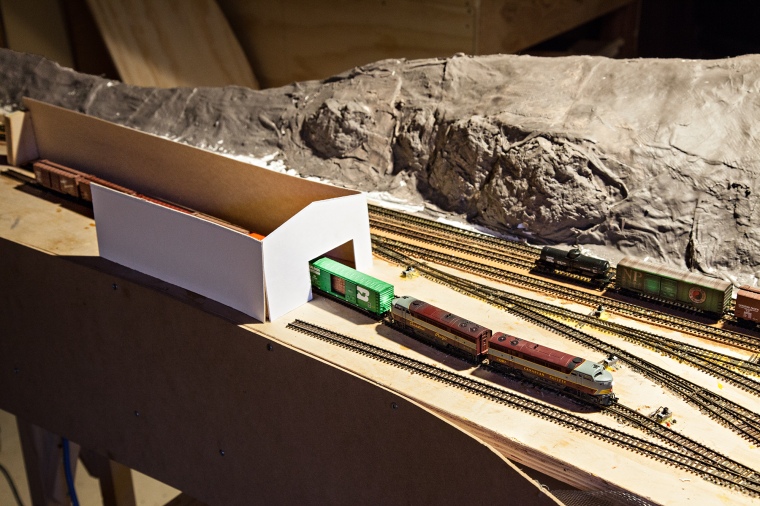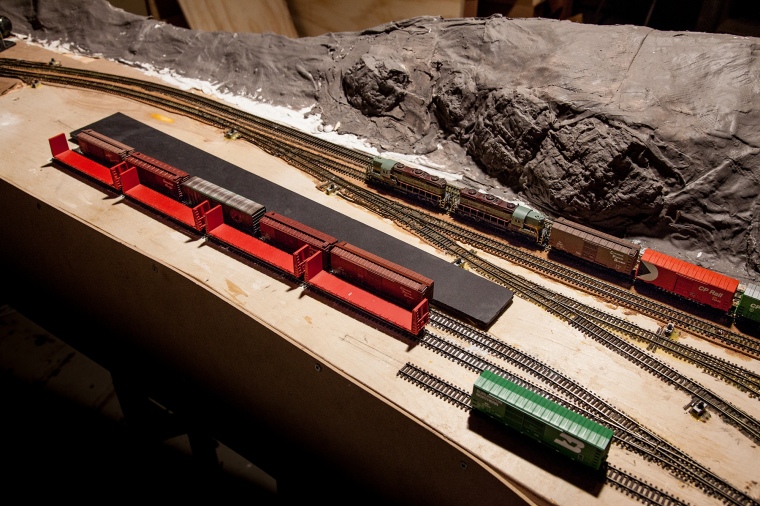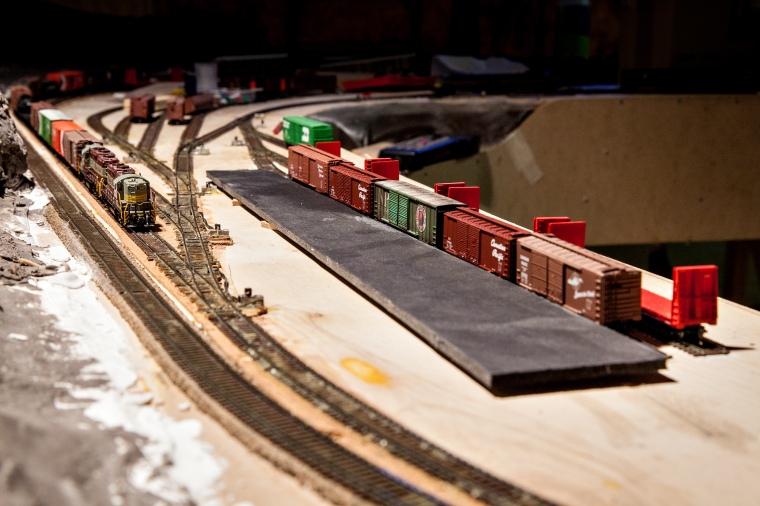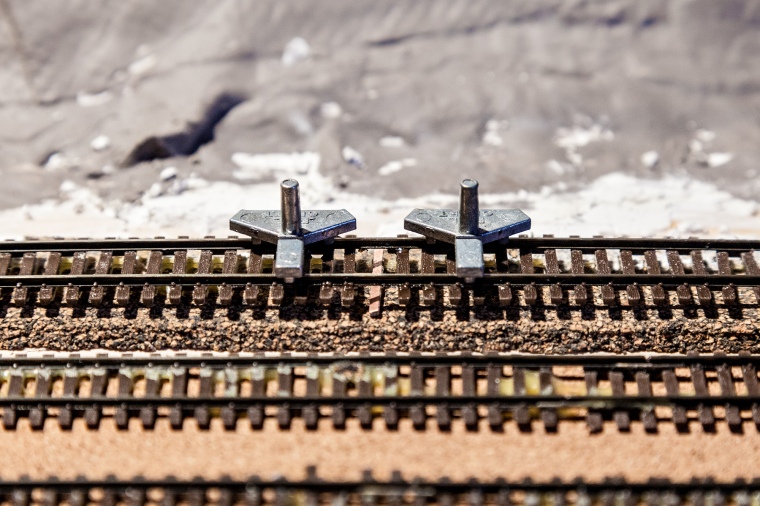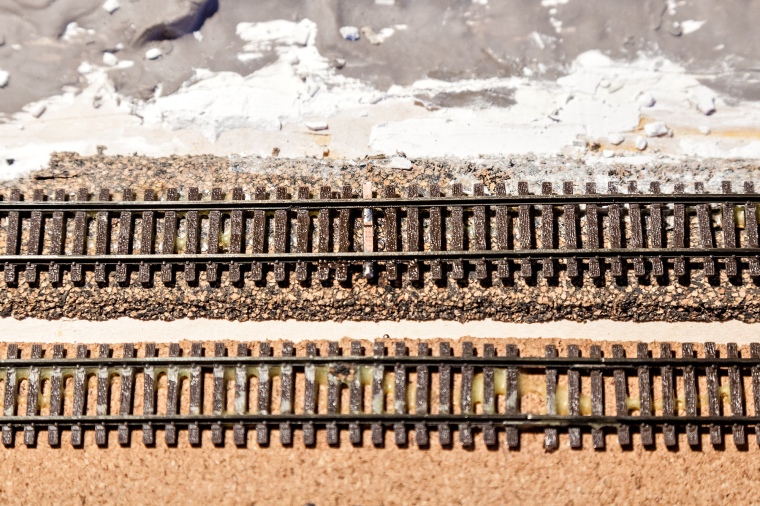An operator at a session last year unintentionally unleashed a demon on my layout.
“When are you going to put in Creston?”
When…when am I….well, first I have to figure out the track plan and proper operations, which have an impact on Nelson and Cranbrook. Looking into those, I realized I had a problem – the east siding switch of Creston was only about 400 feet from the west siding switch of Cranbrook. That was going to cause some problems! I decided to solve that as well as another problem at once by adding some run. But there’s no more room to expand the layout! Unless you think…. UP!
Here’s my Cranbrook, ca. 2017. It was in this configuration for less than a year! I had roughed in a middle level for stub ended storage tracks, approx. 2400′ long, for whatever I wanted to shove in from the non-existent helix that I had intended to connect the east and west ends of the layout with but never built or needed.
Here’s the old plan:
You can see the issue – this is compounded because operators have to walk around a fair distance to get from Creston to Cranbrook due to the furnace and water heater being in the way.
In real life, east of Creston, the line climbs up a maximum 1.25% grade up the Goat river to a summit at Goatfell before descending a short downhill to Yahk. There’s not too much on the way, the small town of Kitchener (station name McConnel to avoid confusion with Kitchener, ON, as the CP didn’t allow duplicate names on its system), but what really catches my eye are two features. First, east of Erickson (a stone’s throw from Creston) the railway crosses the Goat river’s box canyon at the town of Canyon (Original!) on a pretty darn nice bridge.
Canyon-Lister road also passes over the river and under the rail line, as you can see.
Up past McConnel, the line goes around a pretty nifty horseshoe curve that’s hidden by trees. I’ve never seen a photo of a train on it, but it’s plainly visible on google maps.
https://goo.gl/maps/bbGrt95h23s

I realized that I had plenty of space to incorporate both of these, but I felt like I needed something more in the wide scene. I chose to add a 15′ wooden trestle that exists up at Goatfell. It should be a culvert, but instead, it’s a great project!
I drew up plans to move Cranbrook from its current elevation at 0.5″ to 12.5″. After some experimentation, I decided this was the minimum deck separation from the lower deck that would allow it to be scenically workable. This also left enough room to access Cranbrook under Midway. Here’s the new plan:
You can see the Canyon bridge on the original alignment (which was dictated by the furnace and studs) leading up to the horseshoe curve before going through a 2 turn helix to bring it to Cranbrook’s new height. The grade is 1.25% from Creston onto the bridge, going up to 2.0% about the midpoint of the room through the horseshoe – more on that later.
Up in Cranbrook, I originally designed it with 6 run-through tracks and 1 shorter stub track. I guess I wasn’t paying attention when everyone said that you need to design more staging than you think you need! I added 1 long and 3 shorter run-through tracks (800-1000′) and removed the stub track. I moved the reverse loop to the right side of the room, keeping it on the east end of the line, as the tracks in Cranbrook were now reversed east to west.
Building a wedding cake helix:
I wanted the grade in the helix itself to be as mild as possible. My other helix continues with the 2.65% ruling grade of the Boundary sub, but I didn’t want to have such a prominent grade be an obstacle to operations. (The other one is so on purpose)
The grade is 2.0% coming through the horseshoe curve, but lessens to 1.75% through the helix. Why? Two reasons. The ruling grade is in the curve, which means that if a train either can’t make the hill you’ll know right away, and worse, if it stringlines, it’s going to do it where you can easily get it back on the rails without screwing around in a well-designed and accessible helix.
With the grade being 1.75% throughout the helix, but that meant that the separation between levels was going to be 2.1″ railhead to railhead. That’s not a whole lot! I decided to make the helix out of a 1/4″ plywood base supported every 6-8″ and 1/8″ hardboard on top of that to join the plywood together. Take away another 1/8″ for the ties and rails, and that leaves 1-5/8″ clearance above the rail. Note that this is slightly more than the NMRA recommended 1-9/16″, but that doesn’t allow for fingers. I cut them in arcs from smaller pieces I had kicking around. I designed it as an upside down wedding cake style so that you can reach in from above as well as the side, making access much easier. The radius expands by 1″ every level, giving (as you’d expect) a 1″ offset from one level to the next.
I basically laminated the two layers together with wood glue and a ton of clamps.
Here’s an overview before I wrapped the outside in hardboard.
Moving the Cranbrook Staging Yard:
So I’m adding a couple tracks, does that mean I want to rip out the whole yard? No – and it’s designed sectionally, as is the rest of my layout. So why not take it apart and put it back together? Sounds easy! Of course it’s not. Coming apart went well. I used my ultra thin dremel cutoff wheel to gap all the rails first.
Took out all the screws, and she’s free!
I disconnected the wires from their terminal strips at the section joins and carefully pulled everything apart, making sure none of my additions were looped or stuck, removing the occasional piece of benchwork to free some wire or another until the section was free.
Then things started to get weird.
This just felt wrong! Anyway, those stayed like that for the next couple weeks while I tore out the old benchwork and put in new. Things were very messy during this time. I was able to reuse about half of what was there before, but other changes were too big and I had to add new L girders and joists.
One complication: My wider helix was closer to the wall than the original curve into the yard, so I have to shave a couple inches off that section, in a straight line. I clamped a 1×3 in precisely the right spot to keep the blade of my circular saw where it should be, and prayed that I wouldn’t destroy my track.
In the end, I only messed up the flex a little bit and broke one PCB tie on the turnout. Not too bad!
I added in 2 additional turnouts to this ladder as well as a small extension on the table to accommodate the 2 extra tracks. I put the turnouts in while the section was still loose, it was the easiest way to work and didn’t have me hunched into the corner for hours.
I also cut a new ladder of 3#8 turnouts in at the back. I chose 8s because the angle more closely matched how the yard came away from the wall.
Moving the yard over by those few inches also left me with a choice – do I move the whole yard over, or make it slightly longer? Might as well make it longer! It was easier on a few tracks to replace the flextrack to the next join rather than splice in a 4″ section. I added the other new tracks later in order to get the layout running faster.
Out by the furnace, I had to replace the dispatcher’s panel as it was soaked by a leak from the furnace humidifier that I didn’t realize was even on, so I built a sort of box to support both the Cranbrook reverse loop, the line up from Creston, and the new DS panel. At the same time, I realized this wall isn’t load bearing, so I removed a couple of studs. Hehehe.
Down the Hill to Creston
Let’s jump back a bit. Since the staging yard was gone and accessibility was at an all-time high, it was time to build the grade down to Creston. As I’ve done before, I used xTrackCAD to make the best use of my plywood for the cookie cutter roadbed. I don’t have that file anymore, but here’s one from earlier construction:
That jigsaw was a damn good investment.
Put them all up on risers, as I’ve done a hundred times before – I use shims and levels to make sure the height difference is correct between the risers, as well as to check the risers are level on top.
I left this gap for my tiny trestle. I hadn’t decided if it was going to be as small as in real life (it will be) so I left a bit of extra length and height just in case.
I didn’t use cork roadbed inside the helix, but I did transition to it before the visible run. I’m superelevating the curves using the masking tape method I’ve been using forever. Superelevation looks SO GOOD, GUYS.
I’ve made a change to the way I designed this part from the rest of the layout. Most of the curves on the rest are 18″. Here, I tried some variation, as well as adding a few longer straight sections. There’s an 18″ curve, a 24″ curve, even a 30″ curve! Believe me when I say it looks FANTASTIC.
I mentioned this was all because of Creston, right? While I haven’t yet finalized my design for it, I decided where the mainline was going to go – which isn’t where it was previously. I wanted it to be on a ridiculously wide curve. How was I going to manage that? Well, I decided to grab a piece of 1/4″ hardboard, clamp it to 2 pieces of lumber where the ends were, and let it decide the rest.
Mmmm. If I managed to get it close, that’s about a 110″ radius – a 4° curve!
It was at this point I took a 2 week break from trains to get married. (Sorry, not sorry.)
With that checked off my life goals list, I went back to lay track up from the Kootenay Landing bridge to Cranbrook as well as add in the 4 new staging tracks and reverse loop, put the feeders on, and ran 2 extras back into staging where they belonged!
See what I mean? These curves look fantastic.
Gee, seems empty up there…
You can see the Midway panel kicking around where it shouldn’t be – that’s because it was too tall and interfered with Cranbrook once it was moved. I decided to make a new panel for Midway and make fascia for the staging in order to make it look a bit nice. I also had to make a new panel for Cranbrook. I reused the old bits from both to save myself from a ton of soldering, which constrained me somewhat size-wise.
I combined the Midway panel with the tiny panel that controls the switch into Midway but is on the far side of the backdrop, and made everything tiny and compact.
Cranbrook’s panel was a bit more complicated to move, what with the changes in track configuration and all.
A lot of my electrical looks really good. Here, I was just tired of it all. I stopped caring. I still don’t care.
Time to put the dispatcher panel back! I made a new one that was larger and had room to put random bits of information on.
Then I had an op session. The end. For now.























































